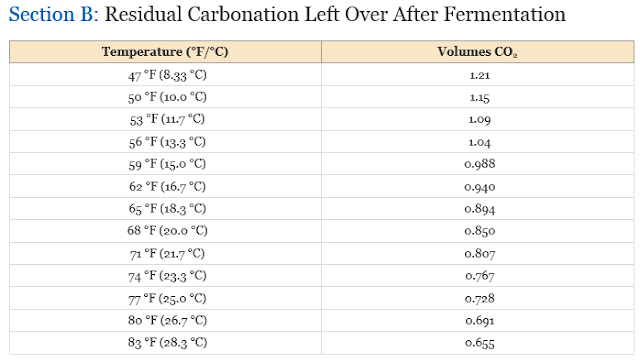The amount of carbonation in bottle-conditioned homebrew is dependent on two things — the residual level of carbon dioxide after fermentation and the amount of carbonation obtained from the priming sugar.
To get the level of carbonation you desire in your homebrew, choose a level of carbonation (from Section A) and subtract the amount of residual carbonation in your beer after fermentation (from Section B). This is the amount of carbonation you to add via priming sugar. The amount of carbonation produced by three different priming agents (anhydrous glucose, glucose monohydrate and sucrose) in 5 gallons (19 L) of beer is given in Section C.
For example, let's say you fermented an American pale ale at 68 °F (20 °C) and plan to carbonate it with corn sugar (glucose monohydrate). From Section A below, you decide that you want your carbonation level to be 2.4 volumes of CO2. From Section B, you see that you should have 0.85 volumes of CO2 in your beer after fermentation at 68 °F (20 °C). Subtracting 0.85 from 2.4 gives you 1.55 volumes of CO2, the amount of carbonation required from the priming sugar. From Section C, you see that adding 4.5 oz. (128 g) yields 1.53 volumes of CO2, which is pretty close.
For example, let's say you fermented an American pale ale at 68 °F (20 °C) and plan to carbonate it with corn sugar (glucose monohydrate). From Section A below, you decide that you want your carbonation level to be 2.4 volumes of CO2. From Section B, you see that you should have 0.85 volumes of CO2 in your beer after fermentation at 68 °F (20 °C). Subtracting 0.85 from 2.4 gives you 1.55 volumes of CO2, the amount of carbonation required from the priming sugar. From Section C, you see that adding 4.5 oz. (128 g) yields 1.53 volumes of CO2, which is pretty close.





No comments:
Post a Comment